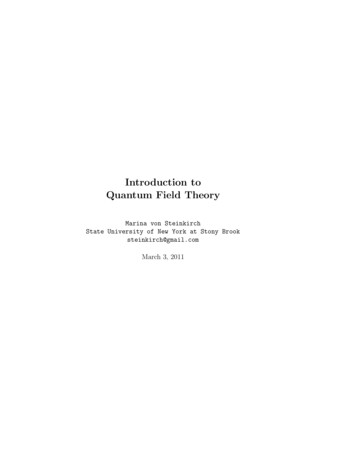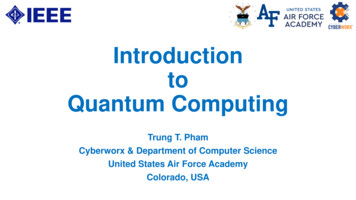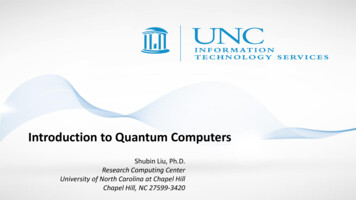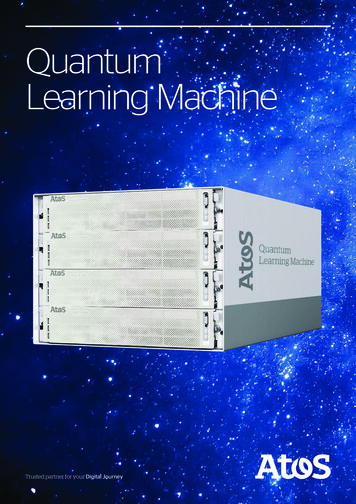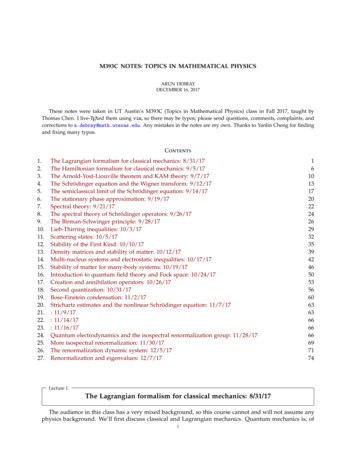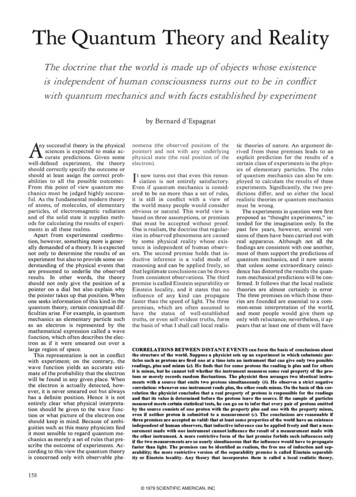
Transcription
TheQuantum Theory and RealityThe doctrine that the world is made up of objects whose existenceis independent of human consciousness turns out to be in conflictwith quantum mechanics and with facts established by experimentby Bernard d 'Espagnat}ty successful theory in the physicalsciences is expected to make ac curate predictions. G iven somewell- defined experiment, the theoryshould correctly specify the outcome orshould at least assign the correct prob abilities to all the possible out comes.From this point of view quantum me chanics must be j udged highly success ful. As the fundamental modern theoryof atoms, of molecules, of elementaryparticles, of electromagnetic radiationand of the solid state it supplies meth ods for calculating the results of experi ments in all these realms.Apart from experimental confirma tion, however, something more is gener ally demanded of a theory. It is expectednot only to determine the results of anexperiment but also to provide some un derstanding of the physical events thatare presumed to underlie the observedresults. In other words, the theoryshould n ot only give the position of apointer on a dial but also explain whythe pointer takes up that position. Whenone seeks information of this kind in thequantum theory, certain conceptual dif ficulties arise. For example, in quantummechanics an elementary particle suchas an electron is represented by themathematical expression called a wavefunction, which often describes the elec tron as if it were smeared out over alarge region of space.This representation is not in conflictwith experiment; on the contrary, thewave fun ction yields an accurate esti mate of the probability that the electronwill be found in any given place. Whenthe electron is actually detected, how ever, it is never smeared out but alwayshas a definite position. Hence it is notentirely clear what physical interpreta tion should be given to the wave func tion or what p icture of the electron oneshould keep in mind. Because of ambi g uities such as this many physicists findit most sensible to regard quantum me chanics as merely a set of rules that pre scribe the outcome of experiments. Ac cording to this view the quantum theoryis concerned only with observable phe-nomena (the observed pOSi tIO n of thepointer) and not with any underlyingphysical state (the real position of theelectron).t now turns out that even this renun ciation is not entirely satisfactory.Even if quantum mechanics is consid ered t o be no m ore than a set of rules,it is st ill in conflict with a view oft he world many people would considerobvious or natural. This world view isbased on three assumptions, or premisest hat m ust be accepted without proof.O ne is realism ,t he doctrine that regular ities in observed phenomena are causedby som e physical reality whose exis tence is independent of h um an observ ers. The second premise holds that in duct ive inference is a valid mode ofreasoning and can be applied freely, sothat legit mi at e conclusions can be drawnfrom consist ent observations. The thirdpremise is called Einstein separability orE instein locality, and ti states that noinfluence of any k ind can propagatefaster t han the speed of light . The threepremises, which are often assumed tohave the status of well-establishedtruths, or even self-evident truths, formthe basis of what I shall call local realis-Itic theories of nature. An argument de riv ed from these premises leads to anexplicit prediction for the results of acertain class of experiments in the phys ics of elementary particles. The rulesof quantum mechanics can also be em ployed to calculate the results of theseexperiments. S ignificantly, the two pre d ictions d iffer, and so e ither the localrealistic theories or quantum mechanicsmust be wrong.The experiments in question were firstproposed as "thought experiments," in t ended for t he imagination only. In thepast few years, however, several ver sions of them have been carried out withreal apparatus. Although not all thefindings are consistent with one another,most of them support the predictions ofquantum mechanics, and it now seemsthat unless some extraordinary coinci dence has distorted the results the quan tum- mechanical predictions will be con firmed . It follows that the local realistictheories are almost certainly in err or .The three premises on which those theo ries are founded are essential to a com mon-sense interpretation of the world,and most people would give them uponly with rel uctance; nevertheless, it ap pears that at least one of them will haveCORRELATIONS BETWEEN DISTANT EVENTS can form the hasis of conclusions aboutthe structure of the world. Suppose a physicist sets up an experiment in which subatomic par ticles such as protons are fired one at a time into an instrument that can give only two possiblereadings, plus and minus(a).He finds that for some protons the reading is plus and for othersit is minus, but he cannot tell whether the instrument measures some real property of the pro tons or merely records random fluctuations. The physicist then arranges two identical instru ments with a source that emits two protons simultaneously(b).He observes a strict negativecorrelation: whenever one instrument reads plus, the other reads minus. On the basis of this cor relation the physicist concludes that a real property of protons is responsible for the readingsand that its valueisdetermined before the protons leave the source. If the sample of particlesmeasured meets certain statistical tests, he can go on to infer that every pair of protons emittedby the source consists of one proton with the property plus and one with the property minus,even if neither proton is submitted to a measurement (c). The conclusions are reasonable ifthree premises are accepted as valid: that at least some properties of the world have an existenceindependent of human observers, that inductive inference can be applied freely and that a mea surement made with one instrument cannot influence the result of a measurement made withthe other instrument. A more restrictive form of the last premise forbids such influences onlyif the two measurements are so nearlysimultaneous that the influence would have to propagatefaster than light. The premises can be identified as realism, the free use of induction and sep arability; the more restrictive version of the separability premise is called Einstain separabil ity or Einstein locality. Any theory that incorporates them is called a local realistic theory.158 1979 SCIENTIFIC AMERICAN, INC
aScoREiT- i- i- -t-tT i- i i-t INSTRUMENT i- 0SOURCEb5COR,EL LEFTINSTRUME NTR.Lt-t i- - - i- -t t-L R.-- R- O ---------LTt--Tt-RIGHTINSTRUMENTT -- CSOURCEINFER.ENCESL tT- i-L-R. t-LT-TTi- ttR.i- i--it-SOURCE159 1979 SCIENTIFIC AMERICAN, INC
nation is called for. It would make nod ifference if the measured values werealways opposite instead of the same; theto be abandoned or modified or in someway constrained.The experiments are concerned withcorrelations between d istant events andwith the causes of those correlations.For example, suppose two particles afew meters apart are found to have iden tical values of some property, such aselectric charge. If this result is obtainedonce or a few times, it might be d is missed as coincidence, but if the corre lation is detected consistently in manymeasurements, a more systematic expla-?correlation would then be a negativeone, but its magnitude would be j ust asgreat, and it would be j ust as unlikely toarise by chance.Whenever a consistent correlation be tween such events is said to be under stood, or to have nothing mysteriousabout it, the explanation offered alwayscites some link of causality. E ither oneevent causes the other or both eventsREALISMh ave a common cause. Until such a linkhas been d iscovered the mind cannotrest satisfied. M oreover, it cannot do soeven if empir ical rules for predicting fu ture correlations are already k nown. Acorrelation between the tides and themotion of the moon was observed in an tiquity, and rules were formulated forpred icting future tides on the basis ofpast experience. The tides could not besaid to be understood, however, untilNewton introd uced his theory of univer sal gravitation.The need to explain observed corre lations is so strong that a commoncause is sometimes postulated evenwhen there is no evidence for it beyondthe correlation itself. Whether or notthis proced ure can always be j ustified isa central issue in the conflict betweenquantum mechanics and local realistictheories. The correlations in questionare between observations of subatomicparticles, where a quantum-mechanicaldescription, with its attendant episte mological hazards, is indispensable. Thepredictions of local realistic theories,however, can be illustra ted by consider 'ing how correlations between d istantevents are explained in a more famil iar context, where quantum mechanicsneed not be introd uced.magine th at a psychologist has de vised a simple test, which a subjectmust either pass or fail, so that therecan be no ambiguity in the results. Thepsychologist finds that some peoplepass and some fail, but he does notknow what d istinguishes the two groupsother than the ir performance on the testitself. In other words, he cannot tellwhether the test measures some real ap titude or attrib ute of· the subjects orwhether the results are haphazard .It seems there is no general solution t othis problem, but in a special c a s e itmight be solved . Suppo se the test is ad ministered not to a series of individualsbut to a series of married couples andthat a strong correlation is detecr ed intheir answers. The proced ure might con sist in separating the husbands from theI(/)wa:oLOCAL REALISTICTHEORIESwIf-QUANTUM MECHANICS\I(/)zoi ()oBELL INEQUALITYIS VALIDBELL INEQUALITYIS SOMETIMES INVALIDwa:[LtEXPERIMENTALTESTRESULTLOCAL REALISTIC THEORIES and quantum mechanics make conflicting predictions forcertain experiments in which distant events are correlated. In particular, local realistic theoriespredict that a relation called the Bell inequality will be obeyed, whereas quantum mechanicspredicts a violation of the inequality. There is strong experimental evidence that the inequalityis violated in theto be untenable,way predicted by quantum mechanics. Local realistic theories therefore seemand at least one of the premises underlying those theories must be in error.160 1979 SCIENTIFIC AMERICAN, INCwives before the test and then giving thetest to each of them in isolation. Whenth e results are analyzed , it is found againthat part of the population has passedand part has failed, but in the case ofeach couple where the husband passedso did the wife; similarly, whenever theh usband failed so did the wife.If this correlation persists after manycouples are tested, the psychologist isalmost sure to conclude that the re sponse of each subject is not determinedrandomly at th e time of testing. On thecontrary, the test must reveal some realproperty or attrib ute of the subjects.The property must already be presentin the subjects before they are tested,and indeed before they are separated.Chance may have had some influenceon the development of th e property,
1979 SCIENTIFIC AMERICAN, INC
: : BELL INEQUALITY, formulated by John S. Bell of the EuropeanOrganization for Nuclear Research (CERN), can be proved in twostages. The inequality applies to experiments with particles that havethree stable properties, A, Band C, each of which can have the valuesplus and minus. Thus tbere are23,or8,possible classes of particles,corresponding to the eight regions of the diagrams shown here. If aparticle has been found to have the properties A and B-, then itmust be a member either of the class A B-C or of the class A B-C-.Hence if N(A B-) represents the number of such particles, it mustbe equal to the sum N(A B-C ) N(A B-C-). In a similar way it canbe shown that N(A C-) is equal to N(A B C-) N(A B-C-),fromwhich it follows that N(A C-) is greater than or at least equal toN(A B-C-). The same reasoning leads to the conclusion that N(B-C )must be greater than or equal to N(A B-C ). These three relationscan now be combined to yield a further inequality, wbich asserts thatthe number of A B- particles cannot exceed the sum of the A C if all signs N(B C-).particles and the B-C particles. The same relation holdsare reversed to give the inequality N(A-B ) N(A-C )The last two inequalities can be added to yield a relation among allindividual particles for which two properties have opposite values.162 1979 SCIENTIFIC AMERICAN, INC"7
since not all the couples possess it, butthat influence must have been exerted atsome time before the husbands and thewives were separated. It was only then,while the husbands and the wives werestill united, that they could have ac quired any traits that would in ducethem to respond consistently the sameway. Thus the correlation is explainedby attributing it to a common cause an tecedent to the test.One other explanation that must beexcluded in deriving this conclusion isthe possibility that husbands and wivescould communicate with each otherwhile they were taking the test. I f somemeans of communication were avail able, there would be no need for anytested attribute to exist beforehand.Whichever spouse' was given the testfirst could choose a response at randomand send instructions to the other, there by creating the observed correlation. Ingiving a psychological test it would notbe hard to guard against subterfuge oft his kind. In the extreme case the testscould be made so nearly simultaneous,or husbands and wives could be tested atsites so far apart, that a signal moving nofaster than light could not arrive in timeto be of any value.Once having decided that the testmeasures some real property of in dividuals, the psychologist can take afurther step and make an inductive in ference. If the couples already testedconstitute an unbiased sample of somepopulation of couples, and if the samplemeets certain statistical standards, thepsychologist can infer that any coupletaken from the same population will bemade up of a husband and a wife whoe ither both possess or both do not pos sess the property measured by the test.By the same prin ciple he can concludethat in any large, unbiased sample ofcouples who have not yet been testedsome of the couples will have the prop erty and some w ill not. The confidenceof these assertions approaches certain ty as the siz e of the sample increases.Hence both the correlation within cou ples and the existence of d ifferences be tween couples are inferred to exist evenin the segment of the population that hasnot been submitted to any test.These concl usions rest on the samethree premises that form the basis of lo cal realistic theories. Realism is a neces sary assumption if one is to believe atleast some tests measure stable proper ties that exist independently of the ex perimenter. It was necessary to assumethe validity of inductive inference in or der to extrapolate from the observeddata to the segment of the populationthat had not yet been tested . Separabili ty was incorporated in the assumptionthat husbands an d wives being testedcannot commun icate with each other. Ifthe tests are given simu ltaneously, sothat any signal passing between hus-163 1979 SCIENTIFIC AMERICAN, INC
THEB 528i.A CAR THAT ITSTHEDBIANDSOFTHE80 WITHOUT VIOLATINGTHE CONCEPT OF A BMW.Conventional automotive wis dom has it that any increase in a car'senvironmental control paraphernaliamust inevitably result in a corre sponding decrease in performance.Indeed, many serious automo tive writers have warned that pollu tion systems and fuel efficiencyregulations have all but sounded thedeath knell for high-performanceautomobiles.These gloomy predictions,however, do not take into consider ation the determination of the engi neers at the Bavarian Motor Worksto build extraordinary automobiles.Against all odds, the BMW528i not only meets the demands ofsociety, it also provides the kind ofexhilarating driving experience thatmost people have all but given upfor lost in today's lUXUry automobiles.AMIDST INCREASI NG MEDIOC RITY, BMW GETS EVEN BEDER.Press the accelerator and the528i's fuel-injected, six-cylinder,overhead cam engine responds in amanner that can only be describedas exhilarating.And yet, the 528i (with stan dard transmission) delivers animpressiveEPA estimated mpg,26 estimated highway mileage and,based on these figures an esti mated mpg range ofl2 91 miles anda highway range of 426 miles.(Naturally our fuel efficiencyfigures are for comparison purposesonly. Your actual mileage and rangemay vary, depending on speed,weather and trip length. Your actualhighway mileage and highwayrange will most likely be lower.)Its four-speed manual trans mission (automatic is available) runssmoothly and precisely up throughthe gears.Its suspension system-indepen dent on all four wheels-provides thedriver with an uncanny feel of the road.Dll7 1979 BMW of North America. Inc. The BMW trademark and logo are registered trademarks of Bayerische Motoren Werke, A.G. 1979 SCIENTIFIC AMERICAN, INCAnd, while the 528i providesas long a list of lUxury items as onecould sanely require-AM/FMstereo cassette, full-power acces sories, air conditioning, etc.-its lux ury is purposefully engineered tohelp prevent driver fatigue.Vital controls are within easyreach; the tachometer, speedom eter and ancillary instruments arewell-marked and easy to read.Its front seats are designed tohold their occupants firmly in place,and are so thoroughly adjustablethat it is all but impossible not tofind a comfortable seating position.If you'd care to judge the ex traordinary performance of the528; for yourself, phoneyour nearest BMW dealer and he will arrangea thorough test drive atyour convenience.' &THE ULTIMATE DRIVING MACHINE.Bavarian Motor Works, Munich, Germany.
bands and wives would h ave to propa gate faster th an th e speed of ligh t, th eassumption is eq uivalent to Einsteinseparability.At first th e conclusions drawn fromthish ypoth etical experiment in psych ol ogy seem to follow q uite obviously fromthe data. An epistemologist migh t none theless maintain th at th e conclusions areuncertain. In particular an epistemolo gist trained in th e foundations of quan tum mech anics migh t argue th at th ere isno logical necessity for accepting th ethree premises of th e psych ologist's ar gument; h ence neith er would it be neces sary to conclude th at a correlation exist ed between th e h usbands and wives be fore th ey were tested, or th at d ifferen ces existed between th e couples beforeany tests were given. The psych ologist islikely to find th ese objections laugh able,an expression of misplaced doubt or of avery unscientific adh erence to paradox.In th e literature of quantum mech anics,however, th ere are numerous argumentssimilar or e quivalent in form to th is one,all p urporting to sh ow th at correlationsand differences need not exist until th eyare measured.A singular feature of quantum me ch anics is th at its predictions generallygive only th e probability of an event, nota deterministic statement that the eventwill happen or that it will not. Th e wavefunction employed to de scribe th e mo tion of an elementary particle is ofteninterpreted probabilistically: the proba bility of finding the particle at any givenpoint is proportional to th e square ofthe wave function at th at point. As Imentioned above, a wave function cansometimes be spread out over a largeregion, wh ich implies th at the probabili ty can also be broadly distributed. Ofcourse, wh en a measurement is actuallymade at some ch osen point, th e particlemust eith er be detected or not be detect ed; the wave function is th en said to col lapse. S uppose th e particle is detected.Th e question of epistemological interestis th en: Did th e particle have th at defi n ite position all along, even before th emeasurement was made?Th e conclusions of th e psych ologist,if th ey could be transferred to this con text, wo uld imply th at th e position ofthe particle was well defined from th estart, j ust as th e attribute d iscovered insome members of th e population wasdeduced toh ave existed before any testswere given. Accord ing to th is argumentthe position of th e particle was neverindeterminate but was merely unknownto th e experimenter.ost authorities on th e quantum th e ory would d isagree. One excep t ion among ph ysicists was Einstein, wh ot hroughouth is life remained d issatisfiedwith the probabilistic nature of th e in t erpretations generally given to quan t um mech anics. He based h is most inci sive criticism of th ose interpretations onMan argument th at was somewh at similarto th e one I h ave attributed to th e psy ch ologist. In 1935 Einstein publish ed apaper with two young colleagues, BorisPodolsky and Nath an Rosen, in wh ichh e stated h is objections explicitly. Hedid not maintain th at th e quantum th eo ry is wrong; on th e contrary ,h e assumedthat at least some of its predictions mustbe correct. Wh at h e proposed was th atthe quantum-mech anical description ofnature is incomplete or approximate.Th e motion of a particle must be de scribe d in terms of probabilities, h e ar gued, only because some of the parame ters th at determine th e motion h ave notyet been specified. If th e values of th eseh ypoth etical "h idden parameters" wereknown, a fully deterministic trajectorycould be defined.A number of counterarg uments toEinstein's proposalh ave been formulat ed. For now I sh all mention only one ofth em, wh ich is based on th e criterion ofutility. It is immaterial, the argumentstates, wh eth er or not hidden parame ters exist, or whether d ifferences be tween married couples exist in th e ab sence of a test. Even if th ey do exist, th eysh ould not be incorporated into any th e ory devised to explain th e observations,and so th ey can be said to h ave no sci entific existence. Th e exclusion of th ehidden parameters is justified by th econjunction of three facts. F irst, th emathematical formalism of th e th eoryis simpler if any hidden parameters areignored. Second, th is simple formalismpredicts results that are confirmed byexperiment. Third, add ing th e h iddenparameters to th e th eory would give riseto no supplem entary pred ictions th atcould be verified. Th us th e assertion th ath idden param eters exist is beyond th ereach of experiment and is a propositionnot of ph ysics but of metaph ysics.Th is defense of th e conventional in terpretation of q uantum mech anics dis m isses any h idden parameters as be ingsuperfluous and ultimately, perh aps,meaningless. Recent th eoretical devel opments have sh own th at th e ir actualstatus is quite d ifferent. Th e h ypoth esisth at hidden parameters exist does in factlead to experimental pred ictions d iffer ing from th ose of quantum mech anics.Hidden-parameter theories, and localrealistic th eories in general, place a lim it on th e extent to wh ich certain dis tant events can be correlated; quantummech anics, in contradistinction, predictsth at under some circumstances th e limitwill be exceeded. Hence it sh ould bepossible, at least in principle, to devisean experimental test that will d iscrimi nate between th e two th eories.Suppose a ph ysicist h as devised a testthat can be carried out on subatomicparticles such as protons. After manytrialsh e finds th at some protons pass th etest and oth ers fail, buth e does not k nowwh eth erh e is measuring some real prop-erty of th e protons or merely observingrandom fl uctuations in h is apparatus.He th erefore tries applying th e test notto individual protons but to pairs ofth em. Th e protons th at make up eachpair are initially in close proxim ity,h aving been brough t togeth er by somewell-defined procedure th at is th e samefor all th e pairs. Th e protons are th enallowed to separate, and wh en th eyh ave moved some macroscopic distanceapart, th ey are tested, simultaneouslyfor some pairs and with an interval be tween th e tests for th e remaining pairs.The ph ysicist d iscovers a strict negativecorre lation: wh enever one proton in apair passes th e test, th e oth er proton in variably fails.Th e situation of th e ph ysicist h as ob vious similarities to th at of th e psych ol ogist giving a test to married couples,and th e same reasoning migh t be ap plied to th e results of th e ph ysical exper iment. If realism, th e free use of induc tion and Einstein separability are all ac cepted as premises, th en th e ph ysicist isj ustified in concluding th at h is test doesmeasure some real property of protons.For th e correlation to be explained th eproperty must exist before th e protonsin each pair are separated, and it musth ave some definite value from th en untilth e measurement is made. Furth ermore,if add itional pairs of protons are pre pared by th e same meth od, the ph ysicistknows th at in each case one proton willh ave th e property and one will not, evenif neith er proton is actually tested .Is th ere a n y r e a l t e s t th at c a n be car ried out on s ubatomic particles with re sults like th ese? There is. It is a measure ment of any one component, definedalong some arbitrary axis, of th e spin ofa particle. Th e spin attributed to a suba tomic particle is analogous only in somerespects to th e spin angular momentumof a macroscopic body such as th e earth.For th e purposes of th is disc ussion,h owever, th ere is no need to introducethe details of h ow spin is treated inquantum mech anics. It will suffice tonote th at th e spin of a particle is repre sented by a vector, or arrow, th at can beimagined as being attach ed to th e parti cle. A projection of th is vector onto anyaxis in th ree-dimensional space is th ecOl1l ponent of th e spin along th at axis. Awell-establish ed but nonetheless sur prising property of protons (and manyoth er particles) is th at no matter wh ataxis is ch osen for a measurement of aspin component th e result can take ononly one of two values, wh ich I sh alldesignate plus and minus. (A measure ment of a component of th e earth ' s spinwould give very d ifferent results; de pend ing on th e d irection of th e compo nent, it could h ave any value from zeroup to th e total angular momentum ofth e earth. )A strict negative correlation betweenspin components is observed wh en anytwo protons are brough t togeth er in165 1979 SCIENTIFIC AMERICAN, INC
the quantum -m echani cal configurati oncalled the si nglet state. In other words,i ftwo protons i n the si nglet state are al lowed to separate and the sam e com po nent of spi n i s subsequently m easuredon both parti cles, i t will always be plusfor one proton and m inus for the other.There i s no known means of predi ctingwhi ch parti cle wi ll have the plus com po nent and whi ch the mi nus component,but the negati ve correlation i s well es tablished. It m akes no d ifference whatcomponent of the spin the experi menterchooses to m easure, provided the sam ecomponent i s m easured for b o th parti cles. It alsom akes no d ifference how farthe protons travel before the m easure ment i s m ade. as long as there are noperturbi ngi nfluences, such as other par ti cles or radi ation, along their paths.n this sim ple measurement there i sno confli ct between the predi cti onsof quantum mechanics and those oflocal reali sti c theori es. A confli ct canari se, however, when the experi ment i smade som ewhat m ore compli cated.The vector that represents the spi nIof a parti cle i s defined by com ponentsalong three axes i n space, whi ch neednot necessari ly be at ri ght angles to oneanother. For a vector associ ated wi th am acroscopic objecti n everyday li fe, onewould ass ume as a m atter of course,and with good reason, that all threecomponents have defini te values at alltimes; the value of a com ponent mi ghtbe unknown, buti t cannot be undefined.When this assumpti on i s appli ed to thespin vector of a parti cle, however, i tbecomes highly suspect, and i ndeed i nthe conventi onali nterpretati on of quan tum mechani cs i t i s di smi ssed as an i n stance of a hidden-param eter theory .The problem i s that no experiment canbe devi sed, eveni n pri nci ple, that wouldprovide i nform ation about the sim ulta neous values of all three com ponents. Asingle instrument can m easure only onespin component, and i n doi ng so i t gen erally alters the values of the com po nents. Hence i n order to learn the val ues of three com ponents threem easure m ents would have to be made i n succes si on. By the tim e the parti cle em ergedfrom the third i nstrum ent i t would noPAI RS OF N EGATIVELYCORRELATEDPARTICLESTEST RES ULTSDEDUC E DPROPERTIESN UMBER OFTEST RES ULTSN UMBER OF PARTICLESWITHDEDUCED PROPERTIESN(A B-) N(A-B ) .;; N(A C-) N(A-C )THEREFORE N(B C-) N(B-C )INE QUALITYDEMONSTRATE DPREVIO USLYBELL INE QUALI TYSECOND STAGE OF THE PROOF extrapolates from tbe case of single particles for wbicbtwo properties are known to tbat of pairs of particles, each particle of whichistested for oneproperty. The pairs are created in sucb a way that there is always a strict negative correlationfor any property considered separately, that is, if one particle in a pair has the propertythe otber must bave tbe propertyfound to beAA ,-. Because of this correlation, if one particle in a pair isA and the otber is found to be B , it is possible to deduce both properties of bothparticles. The doubly positive test result can arise only if one particle has the two propertiesA -B . Hence the number of sucb doubly positive testn[A B 1, must be proportional to the total number of parti cles with the properties A B- and A B . Similar proportionalities can be derived for the num ber of doubly positive results observed when pairs of particles are tested for properties Aand Cand
The Quantum Theory and Reality The doctrine that the world is made up of objects whose existence is independe




